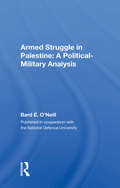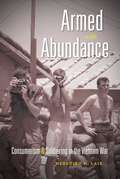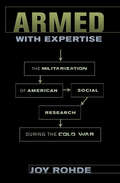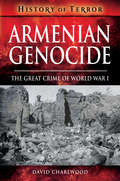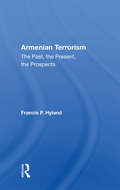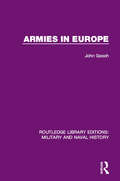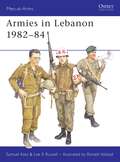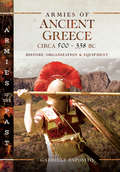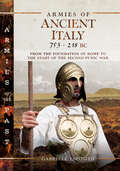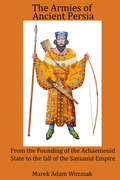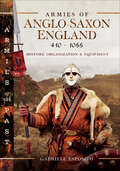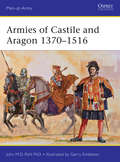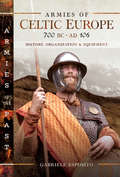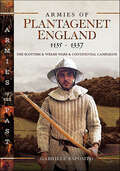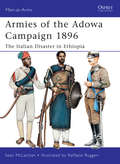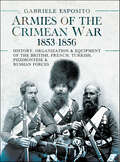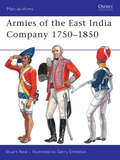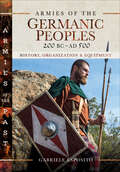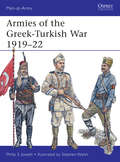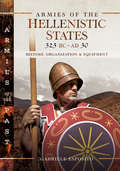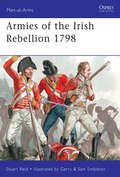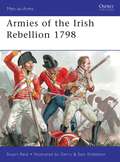- Table View
- List View
Armed Struggle In Palestine: A Political-military Analysis
by Bard E. O'neillBard O'Neill investigates the Palestinian guerrilla movement and assesses the probability that the fedayeen will achieve their aim of liberating Palestine-including Israel-by means of protracted revolutionary insurgency. His analytic framework incorporates several factors that have a critical bearing on the outcomes of protracted insurgencies; thes
Armed with Abundance
by Meredith H. LairPopular representations of the Vietnam War tend to emphasize violence, deprivation, and trauma. By contrast, in Armed with Abundance, Meredith Lair focuses on the noncombat experiences of U.S. soldiers in Vietnam, redrawing the landscape of the war so that swimming pools, ice cream, visits from celebrities, and other "comforts" share the frame with combat.To address a tenuous morale situation, military authorities, Lair reveals, wielded abundance to insulate soldiers--and, by extension, the American public--from boredom and deprivation, making the project of war perhaps easier and certainly more palatable. The result was dozens of overbuilt bases in South Vietnam that grew more elaborate as the war dragged on. Relying on memoirs, military documents, and G.I. newspapers, Lair finds that consumption and satiety, rather than privation and sacrifice, defined most soldiers' Vietnam deployments. Abundance quarantined the U.S. occupation force from the impoverished people it ostensibly had come to liberate, undermining efforts to win Vietnamese "hearts and minds" and burdening veterans with disappointment that their wartime service did not measure up to public expectations. With an epilogue that finds a similar paradigm at work in Iraq, Armed with Abundance offers a unique and provocative perspective on modern American warfare.
Armed with Expertise: The Militarization of American Social Research during the Cold War (American Institutions and Society)
by Joy RohdeDuring the height of the wars in Iraq and Afghanistan, the Pentagon launched a controversial counterinsurgency program called the Human Terrain System. The program embedded social scientists within military units to provide commanders with information about the cultures and grievances of local populations. Yet the controversy it inspired was not new. Decades earlier, similar national security concerns brought the Department of Defense and American social scientists together in the search for intellectual weapons that could combat the spread of communism during the Cold War. In Armed with Expertise, Joy Rohde traces the optimistic rise, anguished fall, and surprising rebirth of Cold War–era military-sponsored social research.Seeking expert knowledge that would enable the United States to contain communism, the Pentagon turned to social scientists. Beginning in the 1950s, political scientists, social psychologists, and anthropologists optimistically applied their expertise to military problems, convinced that their work would enhance democracy around the world. As Rohde shows, by the late 1960s, a growing number of scholars and activists condemned Pentagon-funded social scientists as handmaidens of a technocratic warfare state and sought to eliminate military-sponsored research from American intellectual life.But the Pentagon's social research projects had remarkable institutional momentum and intellectual flexibility. Instead of severing their ties to the military, the Pentagon’s experts relocated to a burgeoning network of private consulting agencies and for-profit research offices. Now shielded from public scrutiny, they continued to influence national security affairs. They also diversified their portfolios to include the study of domestic problems, including urban violence and racial conflict. In examining the controversies over Cold War social science, Rohde reveals the persistent militarization of American political and intellectual life, a phenomenon that continues to raise grave questions about the relationship between expert knowledge and American democracy.
Armenian Genocide: The Great Crime of World War I (History of Terror)
by David CharlwoodThis short history sheds light on the slaughter and expulsion of ethnic Armenians during WWI with stories of those who witnesses the terror firsthand. Twenty years before the start of Hitler&’s Holocaust, over 1.5 million Armenians were murdered by the Turkish state. They were crammed into cattle trucks and deported to camps, shot and buried in mass graves, or force-marched to death. It was described as a crime against humanity and Turkey was condemned by Russia, France, Great Britain and the United States. But two decades later the genocide had been conveniently forgotten. Hitler justified his Polish death squads by asking in 1939: &‘Who after all is today speaking about the destruction of the Armenians?&’ In Armenian Genocide, historian David Charlwood presents a gripping short history of a forgotten genocide. With vivid eyewitness accounts, this volume recalls the men and women who died, the few who survived, and the diplomats who tried to intervene.
Armenian Terrorism: The Past, The Present, The Prospects
by Francis P HylandArising seemingly out of nowhere, Armenian terrorist groups in the last two decades have carried out over 200 attacks in some two dozen countries around the world. Although this wave of terror at first appears to have sprung up without warning, a closer look at Armenian history, especially since World War I, shows that it is only the most recent in a series of outbreaks of ethnic violence. In this study, the author examines the social and political background of Armenian terrorism and its similarities to and differences from other terrorist movements, and he carefully dissects the organizational methods of these groups. An important feature of the work is an extensive and detailed chronology of Armenian terrorism from 1915 to the present. Each entry provides essential information concerning the date and time of the attack, location, victims, weapons used, terrorist groups and individual commandos responsible for the attack, and a list of sources for further reference. A resource for specialists studying terrorism and ethnic violence, "Armenian Terrorism" should also be useful to those interested in the tragic and difficult history of Armenia and Turkey.
Armies in Europe (Routledge Library Editions: Military and Naval History #14)
by John GoochThis book, originally published in 1980, is a study of the nature and purposes of peace-time military organization in Europe, and of the characteristics and outcome of the major wars fought during these years. It charts the rise of mass armies and the role of conscription as a socializing agent and a military instrument, as well as discussing the growing involvement of society in war both as agent and target of military activity, the mounting effort required of a society in order to ahcieve victory, culminating in the ‘Total War’ of 1939-45. Among other subjects explored are the development of war economies, the genesis and significance of war aims, the importance of social cohesion in modern war and the impact of technology.
Armies in Lebanon 1982-84
by Ronald Volstad Sam KatzThe Lebanese Civil War of 1975-76 caused 80,000 dead and totally split the country along factional lines. An estimated 50 different militias came into existence, and acts of violence were both individual and collective. In the midst of this explosive atmosphere, cross-border conflict between Israel and Lebanon intensified, culminating in Operation Peace for Galilee - the invasion of Lebanon. This book offers a day-by-day account of the invasion and the subsequent siege of Beirut, an operation that resulted in both the PLO and Israel claiming victory. Numerous photographs and colour plates portray the uniforms and equipment of the Israeli, Palestinian and Multi-National forces.
Armies of Ancient Greece Circa 500–338 BC: History, Organization & Equipment (Armies Of The Past Ser.)
by Gabriele EspositoIllustrated with color photos, this guide details the arms, armor, organization, and tactics of Classical Greek armies.The Classical period includes some of the most famous wars and battles of Ancient Greece, including the defeat of the Persians at Marathon, the Spartans’ last stand at Thermopylae, the Peloponnesian War and the March of the Ten Thousand. The Greek heavy infantry spearmen, or hoplites, are one of the most recognizable types of ancient warrior and their tightly-packed phalanx formation dominated the battlefield.Covering the period from the Persian Wars to the Macedonian victory at the Battle of Chaeronea, Gabriele Esposito examines the famous hoplites heavy infantry as well as other troops, such as light infantry skirmishers and cavalry. His clear, informative text is beautifully illustrated with dozens of color photographs showing how the equipment was worn and used.
Armies of Ancient Italy, 753–218 BC: From the Foundation of Rome to the Start of the Second Punic War (Armies of the Past)
by Gabriele EspositoA military history of ancient Italy, featuring details of the weapons, equipment, and tactics, as well as color photos showing how warriors looked.Before becoming the masters of the Mediterranean world, the Romans had first to conquer the Italian peninsula in a series of harsh conflicts against its other varied and warlike residents. The outcome was no foregone conclusion and it took the Romans half a millennium to secure the whole of Italy.In Armies of Ancient Italy 753–218 BC, Gabriele Esposito presents the armies that fought these wars, in which the Roman military spirit and their famous legions were forged. He not only follows the evolution of the Roman forces from the Regal Period to the outbreak of the Second Punic War but also the forces of their neighbors, rivals and enemies. The most notable of these, the Etruscans, Samnites and the Italian Greeks are given particular attention but others, such as the Celts and Ligures of the North and the warriors of Sicily and Sardinia, are also considered. Details of the organization, weapons, equipment and tactics of each army are described, while dozens of beautiful color photos of reenactors show how these warriors looked in the field.“Once more, a beautifully illustrated book, this time starting with the story of Rome from the Regal Period to the Second Punic War. The author follows the highly successful format of his books covering the late period of the Roman Empire.—Most Highly Recommended.” —Firetrench“An interesting look at all the people of the Italian era, but what really brings it to life are the countless full colour photographs of re-enactor groups in the correct armour and dress for the various tribes and regions they represent. Excellent production standards and a fascinating look at the history of early Rome.” —The Armourer
Armies of Ancient Persia: From the Founding of the Achaemendid State to the Fall of the Sassanid Empire
by Marek Adam WozniakThe Armies of Ancient Persia is a translation of Marek Adam Wozniak’s original Polish manuscript detailing the rise and fall of the Persian armies from Cyrus the Great to the fall of the Sasanid Empire. Relying on a wealth of recent archeological evidence and studies, Dr. Wozniak provide a detail picture of the recruitment, organization, armament and battles of one of the largest armies of the ancient world
Armies of Anglo-Saxon England 410–1066: History, Organization and Equipment (Armies of the Past)
by Gabriele EspositoIn the early 5th century, Germanic Angles, Saxons and Jutes crossed the North Sea in increasing numbers and began settling among the ruins of the former Roman province of Britannia. This led to centuries of warfare as these 'Anglo-Saxons' carved new, independent kingdoms at the point of the sword, fighting the native Britons and each other. From the late eighth century they also had to face the threat of the Vikings, at first as opportunistic raiders but increasingly bent on conquest. The last Viking invasion was defeated by Harold Godwinson at Stamford Bridge but he was defeated by the Normans in that same fatal year of 1066, ending the Anglo-Saxon Age. Gabriele Esposito gives an overview of Anglo-Saxon military history, narrating the great campaigns, such as those of Alfred the Great of Wessex and Harold Godwinson. He discusses in detail the composition of Anglo-Saxon forces, their tactics, weapons and equipment, detailing developments across the period. The informative, accessible text is supported by dozens of color images showing replica Saxon war gear in use.
Armies of Castile and Aragon 1370-1516
by Gerry Embleton John PohlArmies of Castile and Aragon depicts the fighting men whose skill and tactical flexibility made Spain into a world power at the close of the Middle Ages, carving out empires from the Mediterranean to the Caribbean. Much has been written of the men who fought in the Hundred Years' War between England and France, and the Wars of the Roses. But meanwhile, on the Iberian peninsula, the foundations of Spain's military 'Golden Age' were being laid as the kingdoms of Castile and Aragon under the Trastamara dynasty grew in power, ambition and success. This book features spectacular full-color artwork, and rare manuscript illustrations.
Armies of Celtic Europe, 700 BC–AD 106: History, Organization & Equipment (Armies of the Past)
by Gabriele EspositoA look at the military might of these ancient warriors who sacked Rome and conquered much of Europe. Although comprised of many distinct tribes and groupings, the Celts shared a distinctive culture that dominated much of Europe for centuries, and enjoyed a formidable reputation as fierce and brave warriors, skilled horsemen, and fine metalworkers. In 390 BC, an alliance of Celtic tribes defeated a Roman army at the River Allia and went on to sack Rome and thenceforth the Romans lived under their threat. In the early third century BC, a Celtic army swept into Macedonia and Greece, won a major victory at Thermopylai, and ransacked the sacred sanctuary at Delphi. Such was their warlike prowess that, when not fighting their own wars, they were sought after as mercenaries by many armies, serving as far afield as southern Egypt. When the Romans invaded Gaul—modern-day France and Belgium—and the British Isles, Celtic armies resisted them fiercely. In this book, Gabriele Esposito studies this fascinating warrior culture, their armies, strategy, tactics, and equipment—they invented the horned saddle and chainmail, and British armies were the last in Europe to use chariots on the battlefield. Also included are dozens of color photographs of reenactors to help bring these magnificent warriors back to life.
Armies of Celtic Europe, 700 BC–AD 106: History, Organization & Equipment (Armies of the Past)
by Gabriele EspositoA look at the military might of these ancient warriors who sacked Rome and conquered much of Europe. Although comprised of many distinct tribes and groupings, the Celts shared a distinctive culture that dominated much of Europe for centuries, and enjoyed a formidable reputation as fierce and brave warriors, skilled horsemen, and fine metalworkers. In 390 BC, an alliance of Celtic tribes defeated a Roman army at the River Allia and went on to sack Rome and thenceforth the Romans lived under their threat. In the early third century BC, a Celtic army swept into Macedonia and Greece, won a major victory at Thermopylai, and ransacked the sacred sanctuary at Delphi. Such was their warlike prowess that, when not fighting their own wars, they were sought after as mercenaries by many armies, serving as far afield as southern Egypt. When the Romans invaded Gaul—modern-day France and Belgium—and the British Isles, Celtic armies resisted them fiercely. In this book, Gabriele Esposito studies this fascinating warrior culture, their armies, strategy, tactics, and equipment—they invented the horned saddle and chainmail, and British armies were the last in Europe to use chariots on the battlefield. Also included are dozens of color photographs of reenactors to help bring these magnificent warriors back to life.
Armies of Empire
by Allan ConverseThe study of military history forms a critical part of the Army's learning cycle. By publishing the work of the nation's pre-eminent military historians, the Australian Army and Cambridge University Press aim to promote, to a worldwide audience, our country's proud military heritage. Detailing the history of the Army, its people and its contribution to Australia's development, the series presents readers with contemporary perspectives and authoritative accounts of the key issues in the Army's past. The Australian Army is pleased to collaborate with Cambridge University Press to deliver the official Australian Army History Series. Book jacket.
Armies of Plantagenet England, 1135–1337: The Scottish & Welsh Wars & Continental Campaigns (Armies Of The Past Ser.)
by Gabriele EspositoThe ascent of the Plantagenets to the English throne in 1154 led to the beginning of a new historical phase in the British Isles, which was marked by numerous wars that were fought between the Kingdom of England and the 'Celtic nations' of Wales, Scotland and Ireland. During the rule of the Norman kings, the English armies had not completed the conquest of Wales and had established only some footholds in Ireland; Scotland was still independent and was ready to contest the Plantagenets’ possession of northern England. As a result of this situation, the two centuries between the rise of the new dynasty and the beginning of the Hundred Years’ War were characterized by a series of wars that ravaged feudal England. Gabriele Esposito covers all these conflicts, following the campaigns of Richard the Lionheart as well as those of his younger brother who was defeated on the continent at the large Battle of Bouvines; the conquest of Wales is analyzed in detail, as well as the First Scottish War of Independence that saw William Wallace playing a prominent role. The organization and equipment of all the troop types taken into account is described in full detail and lavishly illustrated with color images of reenactors, bringing these forces to life.
Armies of the Adowa Campaign 1896
by Sean Mclachlan Raffaele RuggeriIn the late 19th century, the new nation-state of Italy was eager to join her European neighbors in creating an international empire. Italy's eyes turned towards Africa as a source of potential colonies. Most of the continent had already been carved up between the Great Powers but Italy succeeded in securing a foothold in Eritrea on the Red Sea coast, a vassal of the Emperor of Ethiopia. Trade and other links were established with the Ethiopian empire but quarrels regarding the interpretation of a particular clause led to Ethiopian support for uprisings in Eritrea. Italian troops entered northern Ethiopia and captured Adowa, the capital of the Tigray province. Full-scale war broke out and this new Osprey title tracks every development in the battle and the men who fought in it.From the Trade Paperback edition.
Armies of the Balkan Wars 1912-13: The Priming Charge for the Great War
by Philip S. JowettIn 1912, the Balkan states formed an alliance in an effort to break free from the crumbling Ottoman Empire. Forming an army of some 645,000 troops from Greece, Bulgaria, Serbia and Montenego, they took on a force of 400,000 Turkish soldiers. Both sides were equipped with the latest weapons technology. This book looks at the diverse and sometimes colorful uniforms worn by both sides, paying special attention to insignia, weapons and equipment. It also gives an overview of the campaign that became a "priming pan" of World War I.
Armies of the Crimean War, 1853–1856: History, Organization and Equipment of the British, French, Turkish, Piedmontese and Russian forces
by Gabriele EspositoLavishly illustrated with over 100 illustrations that detail the composition, organization, uniforms, weapons and equipment of each force. The Crimean War was the first major European war since the end of the Napoleonic Wars and Britain’s only war on that continent in the century between Waterloo and WW1. When Russia invaded provinces of the Ottoman Empire, the British and French, later joined by the Kingdom of Piedmont-Sardinia, intervened to limit Russian expansion towards the Black Sea. Each of the armies contained an eclectic mix of units. The regular European regiments still displayed much of the bright color and finery associated with the Napoleonic era (the British infantry in their scarlet tunics forming the famous ‘thin red line’ at Balaklava for instance), while each also contained a mix of exotic units drawn from across their respective empires. The French fielded Zouaves and Spahis from North and West Africa, not to mention the legendary Foreign Legion; the Ottomans had Tunisians and Egyptians alongside Balkan mountaineers and the infamous Bashi-bazouks; the Russians of course had their Cossacks and the British fielded little-known German, Swiss and Italian mercenaries. Gabriele Esposito details the composition, organization, uniforms and weaponry of each force and illustrates many of them with early black and white photos (this being the first major war for which photography was available), as well as numerous color artworks.
Armies of the East India Company 1750-1850
by Gerry Embleton Stuart ReidContrary to popular belief, the capture of India was not accomplished by the British Army, but by the private armies of the East India Company, whose primary objective was the protection of their trading empire. Under the leadership of the legendary Robert Clive (founder of the East India Company) and Stringer Lawrence, this small force of mercenaries and adventurers grew in size and strength to eventually become an army larger than that of any European sovereign state. Highly disciplined and professional, it fought almost continuously for a century until the Great Mutiny of 1857 led to its disbandment and its troops passed into Crown service. One of the many British Army officers who fought with this force was Arthur Wellesley, the future Duke of Wellington. This is the fascinating history of the East India Company army, examining the many conflicts in which they fought, and their equipment and training, with its regiments of horse, foot and guns, which rivalled those of most European powers. The exotic uniforms combining traditional Indian and British dress are illustrated in detail and make for a wonderfully colorful account of a private band of adventurers that successfully captured the jewel of the British Empire.
Armies of the Germanic Peoples, 200 BC–AD 500: History, Organization & Equipment
by Gabriele EspositoGabriele Esposito presents an overview of the military history of the Germanic peoples of this period and describes in detail the weapons and tactics they employed on the battlefield. He starts by showing how, from very early on, the Germanic communities were heavily influenced by Celtic culture. He then moves on to describe the major military events, starting with the first major encounter between the Germanic tribes and the Romans: the invasion by the Cimbri and Teutones. Julius Caesar's campaigns against German groups seeking to enter Gaul are described in detail as is the pivotal Battle of the Teutoburg Forest, which effectively halted Roman expansion into Germany and for centuries fixed the Rhine as the border between the Roman and Germanic civilizations. Escalating pressure of Germanic raids and invasions was a major factor in the collapse of the Western Roman Empire. The author's analysis explains how Germanic warriors were able to crush the Roman military forces on several occasions, gradually transformed the Roman Army itself from the inside and, after the fall of the Empire, created new Romano-Germanic Kingdoms across Europe. The evolution of Germanic weapons, equipment and tactics is examined and brought to life through dozens of color photos of replica equipment in use.
Armies of the Greek-Turkish War 1919-22
by Philip JowettThis is a comprehensive guide to the armies that fought a devastating and decisive conflict in the Eastern Mediterranean between the two World Wars of the 20th century. From the initial Greek invasion, designed to "liberate" the 100,000 ethnic Greeks that lived in Western Turkey and had done for centuries, to Mustapha Kemal Ataturk's incredibly efficient formation of a national government and a regular army, this was a war that shaped the geopolitical landscape of the Mediterranean to this day. It gave birth to the modern Turkish state, displacing millions and creating bitter memories of atrocities committed by both sides. Augmented with very rare photographs and beautiful illustrations, this ground-breaking title explores the history, organization, and appearance of the armies, both guerilla and conventional, that fought in this bloody war.
Armies of the Hellenistic States, 323 BC–AD 30: History, Organization & Equipment
by Gabriele EspositoThis fully illustrated history chronicles the evolution of Hellenistic warfare from the death of Alexander the Great to Rome&’s conquest of the region. This book provides a complete and detailed analysis of the organization and equipment employed by the armies of the Hellenistic States. After Alexander the Great&’s death in 323 BC, his immense Macedonian empire was divided between his generals, who in turn formed their own monarchies across Eastern Europe, Asia and North Africa. This work will follow the development of the Hellenistic military forces from the army bequeathed by Alexander to the complex military machines that succumbed one by one in the wars against the expanding Romans. Fully illustrated with color photographs, this volume also shows how Hellenistic forces were strongly influenced by Roman models during the last years of independence of their kingdoms. The states analyzed are: Macedon, Seleucid Empire, Ptolemaic Egypt, The Greco-Bactrian Kingdom, Armenia, Pergamon, Pontus, Cappadocia, Galatia, The Bosporan Kingdom, Epirus, Sicily, The Achaean League and The Aetolian League.
Armies of the Irish Rebellion 1798
by Gerry Embleton Stuart ReidA stunning exploration of a legendary moment in Irish history. In 1798 with the British Army preoccupied in fighting France in the Caribbean and Mediterranean as well as guarding Southeast England from threatened invasion, a co-ordinated uprising broke out across the water in Ireland. Uniquely this was neither a Catholic nor a Protestant rebellion, but rather a joint effort by leaders and insurgents from both sides of the community. The Irish Rebellion (1798) was directed against the corrupt government based at Dublin Castle and was inspired in part by the people's revolutions in America and France. This title illuminates the lives of the Irish peasants, armed mostly with pikes, who confronted the small number of British troops based in their country.From the Trade Paperback edition.
Armies of the Irish Rebellion 1798
by Stuart ReidA stunning exploration of a legendary moment in Irish history. In 1798 with the British Army preoccupied in fighting France in the Caribbean and Mediterranean as well as guarding Southeast England from threatened invasion, a co-ordinated uprising broke out across the water in Ireland. Uniquely this was neither a Catholic nor a Protestant rebellion, but rather a joint effort by leaders and insurgents from both sides of the community. The Irish Rebellion (1798) was directed against the corrupt government based at Dublin Castle and was inspired in part by the people's revolutions in America and France. This title illuminates the lives of the Irish peasants, armed mostly with pikes, who confronted the small number of British troops based in their country. From the Trade Paperback edition.
